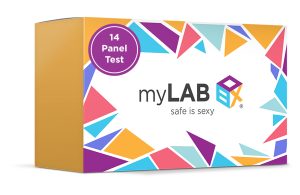How Much Does it Cost to Get Tested for Herpes? (HSV-2)

| ❖ Free physician consultation ❖ Mail-in kits for home use ❖ Test in just 5 minutes ❖ Lab results in 2-5 days ❖ 100% pain free ❖ Enjoy free shipping |
Herpes Test Cost and Insurance
How much does a herpes test cost at myLAB Box? Our at home herpes test costs $79 for both men and women. How much does a herpes test cost at a clinic? Well, that depends on the testing method. Pricing can also vary by location and income. When people visit a clinic or doctor’s office, it’s possible that they’ll be able to use insurance to lower expenses. For many folks, this may not be the best option. When you use insurance, your testing data information is shared on something called the Medical Information Bureau database. This data is accessible by any insurance company. Think of it as a sort of “permanent record” for a person’s health.
This problem doesn’t exist with myLAB Box. Our herpes test cost includes the most valuable thing of all – peace of mind. This means that an individual’s test results will remain private. Each customer receives their results via a secure and confidential portal online. No one else has to know.
Our home testing options are designed to be affordable without the need for insurance. Customers can screen for the most common STDs, including herpes, from the comfort of home for only about half of the out-of-pocket cost of STD testing at clinics and other medical facilities. In addition, we accept most Flexible Savings Account (FSA) and Health Savings Accounts (HSA) payment cards.
Genital herpes is a common sexually transmitted infection (STI). It is caused by either herpes simplex virus type 2 (HSV-2) or type 1 (HSV-1). In general, HSV-2 infects the genital and anal areas of the body. Typically, it is contracted through penile-vaginal sex or penile-anal sex.
HSV-1 is most known for cold sores near the mouth, but can infect the genital area as a result of transmission from the mouth through oral sex. In addition, HSV-1 can be transmitted genitally by penile-vaginal sex or penile-anal sex.
About one in five women ages 14 to 49 years have genital herpes (HSV-2) while one in 10 men in that same age range have it. Genital herpes is more common in women than men because a woman’s anatomy puts her more at risk. As an example, if the vaginal tissue has tears or abrasions, it’s easier to get genital herpes.
Both types of herpes have spread like wildfire throughout the United States in recent years. According to the Centers for Disease Control and Prevention, genital herpes is actually the third most common STI. It is estimated that one out of every six people between the ages of 14 and 49 have contracted genital herpes. This massive infection rate is largely due to the way that herpes is spread. The virus is carried in fluids found in easily breakable herpes sores. Having direct contact with those fluids can cause you to contract the infection.
Although this sexually transmitted infection (STI) is often spread when there’s an open sore, you can still get herpes from someone who isn’t showing symptoms or sores through asymptomatic shedding of the virus.[1] You won’t get herpes from toilet seats, swimming pools, bedding, or from touching objects around you such as silverware, soap, or towels. Bodily fluids must be involved with both parties.
Symptoms of HSV-2 Infection
Although the Herpes Simplex Virus-2 doesn’t usually show symptoms,[1][2] there are a few you should look out for. Some can be so subtle that they are mistaken for an ingrown hair or acne. Because of this, many people will never realize that they are infected without being tested. If they do exist, herpes symptoms can eventually become severe and very painful without proper treatment.
Anyone with genital herpes (HSV-2) may experience symptoms like pain while urinating or consistent headaches, body aches or flu-like symptoms.[3] The HSV-2 infection most commonly appears in the form or sores, lesions or blisters affecting the genital area, thighs, buttocks and the area near the anus. These blisters can break and bleed easily before scabbing over.
For men, a penile herpes infection includes uncomfortable symptoms such as sores on or around the penis and swelling or discomfort in the groin nodes.
For women, a vaginal or pelvic herpes infection can cause discomfort similar to a yeast, bacterial or bladder infection. In addition, sores in or around the vagina, vulva or urethra and bleeding between periods may occur. It is especially important for pregnant women to know if they have herpes, as it is possible to pass it to an infant and cause miscarriage, premature birth or prenatal herpes, which can be fatal.[2]
It is very common to have several outbreaks within the first year of contracting the virus. Since the sores associated with herpes can bleed easily, this infection can put you at an increased risk of acquiring HIV if you come into contact with fluids from the mouth, penis, vagina or rectum during sex with someone who has HIV. The only way to know for sure if you have this sexually transmitted infection is by getting tested.
How Home Herpes Testing Works
As we’ve mentioned, herpes is quite contagious. Keeping that in mind, it is important that people test regardless of whether or not they are experiencing symptoms.
If testing in a doctor’s office or clinic, they’ll take a swab from a sore to test in the lab or take a blood sample to look for genital herpes antibodies. If the antibodies for HSV-2 are found, a person is infected with genital herpes. If HSV-1 antibodies are found, it could be due to cold sores (fever blisters) on the mouth or genital HSV-1. Unfortunately, when most people go to the doctor, their sores have already resolved and taking a swab is not possible.
If exposed to HSV-2, a person could have a positive test for HSV-2 antibodies as soon as a few weeks following exposure. If testing a few weeks after possible exposure to HSV-2, screening could get return a negative result. To be absolutely sure of the negative results, each person should retest for HSV-2 again up to four months after exposure.
myLAB Box offers testing for HSV-2 antibodies which are always due to a sexually transmitted infection. myLAB Box does not offer testing for HSV-1. If you test positive with myLAB Box’s herpes test kit, we will connect you with a free phone consultation with a physician.
Try MyLAB Box’s Discreet at Home Herpes Test Kit
Extragenital Testing
Anyone who has had oral or anal sex should take an extragenital herpes test. In short, The rectal form of herpes is also called “HSV proctitis” in the medical community.
Anal herpes symptoms include:
- Ulcers or sores on or near your anus
- Scabs that cover ulcers that have ruptured or bled
- Bloody stools
- Bloody discharge from the rectum
- Diarrhea
- Pain in the rectum
- White blisters
- Red bumps
- Rashes on your legs, neck, upper body, or trunk
An anal herpes test will tell you if you have the infection. If you test positive, know that there isn’t a cure for herpes but you can get medications to treat it. In some cases, anal herpes has been mistaken for inflammatory bowel disease until an anal herpes test was given.
Oral herpes also requires a separate extragenital test. When combined, these three tests offer the most complete picture of a person’s status.
Genital Herpes Treatment
If the results for a genital herpes test comes back positive for HSV-2, it’s important to know that there is no cure for herpes. It’s a lifelong disease, but no one has to face this alone. Millions of people suffer from genital herpes and researchers are working to find a cure.
Make an appointment with a doctor to discuss medications, how to control outbreaks, as well as what to do—and what to avoid—during an outbreak. Healthcare practitioners can offer medications that relieve the painful symptoms associated with herpes and should lower the risk of passing genital herpes to a partner. Some treatments can even shorten the length of time that each outbreak lasts.
An infected person should always let any partner know about their status. This will let the other person know to take a herpes test as well. Both partners should talk to a doctor about how to prevent passing the infection to others. Additionally, the medical team can explain how to have sex safely during an outbreak. Untreated herpes can lead to more frequent transmission, painful outbreaks and serious health consequences. For example, untreated lesions on the cervix can lead to cervicitis (inflammation of the cervix).
Reviewed by Luis Ferdinand M. Papa, MD, MHA
References
- [1] Study found that asymptomatic carriers of genital herpes are shedding the virus in genital fluid 10.2% of the time in a given month. Symptomatic carriers shed at a rate of 20.1%.
Tronstein E, Johnston C, Huang M, et al. Genital Shedding of Herpes Simplex Virus Among Symptomatic and Asymptomatic Persons With HSV-2 Infection. Journal of the American Medical Association. 2011.
- [2] Study found that herpes developed in 33% of infants whose mothers were infected for the first time at term compared to 3% who had herpes before pregnancy. Of 10 infants who developed herpes at birth, 5 died or were disabled at the time the article was written.
Brown ZA, Benedetti J, Ashley R, et al. Neonatal Herpes Simplex Virus Infection in Relation to Asymptomatic Maternal Infection at the Time of Labor. New England Journal of Medicine. 1991.
- [3] Study found that first-time HSV-2 symptomatic patients often present with headaches, fever, difficult or painful urination, genital pain, discharge and genital lesions.
Diamond C, Selke S, Rhoda A, et al. Clinical Course of Patients With Serologic Evidence of Recurrent Genital Herpes Presenting With Signs and Symptoms of First Episode Disease. Sexually Transmitted Diseases. 1999.
Additional References:
- . The changing epidemiology of HSV-1 and HSV-2 and implications for serological testing. Herpes: The Journal of the IHMF. 2002.
- . The Current Trend in Genital Herpes: Progress in Prevention. Sexually Transmitted Diseases. 1994.
- . The frequency of unrecognized type 2 herpes simplex virus infection among women: Implications for the control of genital herpes. Sexually Transmitted Diseases. 1990.
- . Tests of vaginal microbicides in the mouse genital herpes model. Contraception. 1997.
- . Performance of Commercial Herpes Simplex Virus Type-2 Antibody Tests Using Serum Samples From Sub-Saharan Africa: A Systematic Review and Meta-analysis. Sexually Transmitted Diseases. 2011.
- . Recommendations for the Selective Use of Herpes Simplex Virus Type 2 Serological Tests. Clinical Infectious Diseases. 2005.
- . Privacy Issues with the Electronic Medical Record. Annals of Nursing and Practice. 2014.
- . A Population-Based Study of the Incidence and Complication Rates of Herpes Zoster Before Zoster Vaccine Introduction. Mayo Clinic Proceedings. 2007.
Popular Tests

Total Box
14 Panel STD Test
In Stock – Free Shipping
$369 – $399
